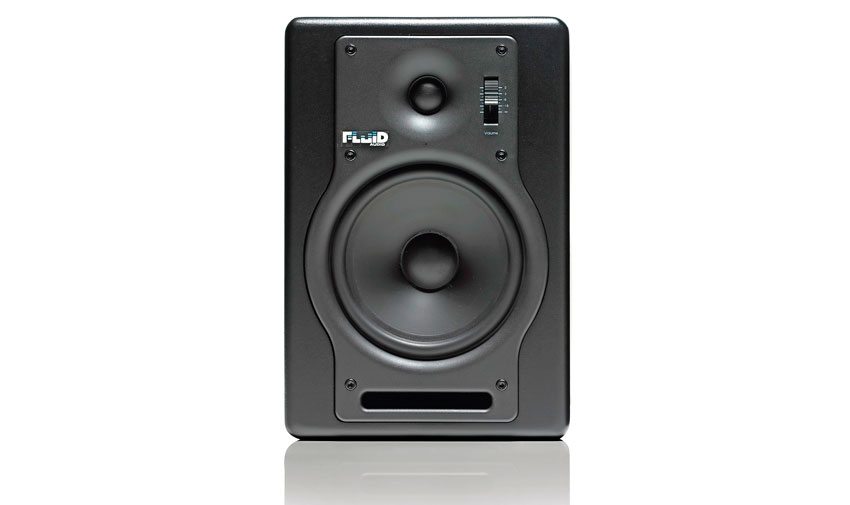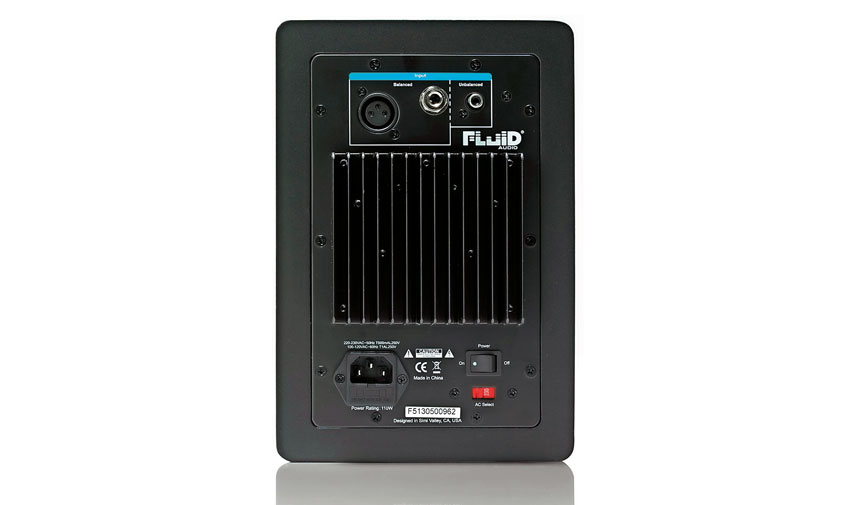MusicRadar Verdict
A real contender in the sub £200 bracket offering smooth highs and some punchy power.
Pros
- +
Smooth HF response. Plenty of power. Solid build.
Cons
- -
Worth placing on stands.
MusicRadar's got your back

Fluid Audio F5

Rear
Fluid Audio has sprung up with three compact powered monitors, with the largest and most costly being the F5. At £199 a pair the F5 is being thrown into a volatile part of the market, so it needs to perform well above its price.
Straight out of the box the F5s feel light but solid. The rear panel sports a finned amplifier " with power inlet/switch below, line inputs above: XLR, TRS and RCA. The rigid plastic front baffle centre houses the silk dome tweeter (in waveguide), coated paper composite woofer, volume trim fader and slot shaped bass reflex port. Between the drivers is a tiny power LED that shines red for a muted standby and blue when running. Standby kicks in after 15 minutes, which is a nice touch.
The volume trim fader is easy to access at the front and offers a full range right down to 'off'. Balancing the stereo field with tiny faders was a tad annoying, but at least there's a detented -6dB position as well as the top 0dB point.
Beef vs the hump
Small LF drivers are an unavoidable limiting factor for compact monitors, whether the cabinet is ported or closed. The F5, with its 5-inch driver, has a quoted low range limit of 49Hz, though in practice the roll off is audible from 80Hz. This is not necessarily a bad thing, it really depends on how evenly the frequency response extends above this.
"There is a pronounced hump in the 100Hz to 200Hz range, giving these monitors a beefy aspect"
In this case there is a pronounced hump in the 100Hz to 200Hz range, giving these monitors a beefy aspect. Speaker characteristics are subjective so this may or may not work for you. We had the F5s next to the monitors we use daily so this characteristic took a little getting used to, but we quickly came to appreciate the perspective they offered.
Small monitors can sound harsh due to their limited low-end leading to the user's mixes ending up dull and hollow. The F5s don't sound harsh, partly due to this compensated low-end. They do overemphasise the body of kick drums and the early harmonics of basses, but so long as you keep these elements well forward in the mix you can use the F5s to listen in to this critical region.
Smooth power
The upper frequency response is very smooth from the mids to the top of the HF range, and this makes working with the F5s a much less fatiguing experience than you would expect for this size and price.
Performance around the crossover region (2.5kHz) is good with no audible sign of the phase response problems indicative of poor crossover circuits. The smooth highs are coupled with a gentle roll out in the final octave (>10kHz), making 'airiness' easy to overcook, but again familiarity would soon alleviate this potential.
They are by no means dull sounding and they can ably translate bite and aggression without compromising clarity. They are punchy and open sounding, with the 70 watts of bi-amplified power proving capable of a surprisingly loud delivery - plenty of clean SPLs for most small/medium rooms. Finally, the off axis response remains stable over a wide angle, which makes for good stereo imaging.
Without a doubt the F5s deliver a performance beyond their price. Good transient response, a smooth mid to HF range and some punchy power make them a good candidate for a small budget.
The slightly bulbous low-end isn't marred by any overt resonant peaks and so should just be a matter of familiarity. We would advise placing them on stands, even short ones, just to keep them up and away from flat surfaces to prevent/reduce comb filtering of this crucial frequency area.
"That's what it takes to make music that's gonna last forever": Olivia Rodrigo and Chappell Roan producer Daniel Nigro on crafting timeless tracks
“A fully playable electro-mechanical synth voice that tracks the pitch of your playing in real time”: Gamechanger Audio unveils the Motor Pedal – a real synth pedal with a “multi-modal gas pedal”
“It was the first rock monster that we'd created”: How an explosive 2001 switch-up revealed just how ferocious Muse could get









